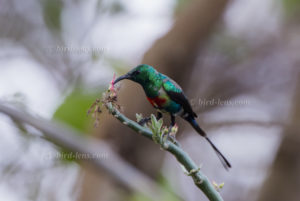 A male Beautiful Sunbird (Cinnyris pulchellus) balances busily and without misstep on a bare stem of a Aloe, which lead to some, small yellowish flowers with red borders. There, the photographer has a chance to shoot the bird, which is aptly called its English name. The male of the Beautiful Sunbird places the rather long, slightly bent black beak against the calyx of the flower and sucks the nectar for a short while. Then the Beautiful Sunbird is already on the way to the next flowering.
A male Beautiful Sunbird (Cinnyris pulchellus) balances busily and without misstep on a bare stem of a Aloe, which lead to some, small yellowish flowers with red borders. There, the photographer has a chance to shoot the bird, which is aptly called its English name. The male of the Beautiful Sunbird places the rather long, slightly bent black beak against the calyx of the flower and sucks the nectar for a short while. Then the Beautiful Sunbird is already on the way to the next flowering.
I had become attentive to the Beautiful Sunbird when I decided to explore the motel area in the Mole National Park in northern Ghana. Along the simple bungalows I ran to the end and discovered a very bird-rich place. A sewage pipe appeared in the middle of dense scrub with many trails to the surface and had created a small pool. You do not want to know which corners of the motel are drained this sewage pipe. Already from a distance, the smells were anything but attractive. But the combination of water and scrub attracted the birds magically. The scrub provided reasonably well protected approach and relaxation after bathing. As a photographer, you could also stand there in the shade of tall, green trees and lean against a thick horizontal branch. So, I could see and photograph in close proximity a Yellow-fronted Canary (Crithagra mozambica caniceps), some Red-cheeked Cordon-bleu (Uraeginthus bengalus), a flock of Lavender Waxbills (Estrilda coerulescens), Common Gonolek or Yellow-crowned Gonolek (Laniarius barbarus) and the Senegal Batis (Batis senegalensis). Some shots were made partly at the border to closest lens distance. A bunting, which reminds me very much of the Rock Bunting (Emberiza cia) is probably the Grey-throated Bunting (Emberiza goslingi), which I actually can only observe here for the whole trip. This also almost applies to a Familiar Chat (Oenanthe familiaris), which shows a bit less cooperative. A Nolan Warthog (Phacochoerus africanus africanus) also comes by and wallows – mostly invisible to me – in the small shallow pond. A Stone Partridge (Ptilopachus petrosus), can be seen only shadowy between twigs and branches. Also a Central Bushbuck (Tragelaphus scriptus) arrives shortly, sees me and runs away with protesting barking. Later, the Central Bushbuck comes back to the pool, secures briefly and then drinks extensively. The Bushbuck looks over to me from time to time. Otherwise, he does not let himself be disturbed.
But one of the most spectacular highlights of this spot was how close you could photograph the colorful Beautiful Sunbird.
The Beautiful Sunbird feeds on nectar and small blooms (e.g. of acacia); Insects and spiders. The Beautiful Sunbird is usually observed individually in the search of food, but does occur occasionally in small groups. The bird visits a variety of different flowers e.g. from Acacia, Silk trees (Albizia sp.), Aloe, Kapok or Cotton Tree (Bombax sp.), Bougainvillea, Milkweeds (Calotropis sp.), Canna Lily or Canna, Bushwillows of the genus Combretum, Myrrh in the family Commiphora, Hibiscus trees, Jacaranda trees etc.
To cope with the growing demand for top shots of the rarer species of the Palearctic Bird-Lens is keen to enrich the range of pictures of birds not only in the western Palearctic. Trips to remote places like this one to capture images were very successful. The nice image of the blog is only a first impression, what you will find in the gallery in the “Picture Shop” very soon. Just give bird-lens.com a message, if www.bird-lens.com could serve you with an image needed before the new pictures are online.